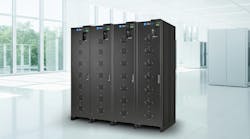Open Compute Project Teams with Hyperscalers to Advance Low-Carbon 'Green Concrete' for Data Centers
The Open Compute Project Foundation (OCP) this month announced that it is facilitating a new collaborative effort among top hyperscalers Amazon Web Services (AWS), Google, Meta, and Microsoft to test development and deployment of low-embodied carbon concrete or "green concrete," the better to drive its adoption in data center construction.
Concrete is said to be the most widely-used man-made material on the planet, and second only to water as the most consumer resource. Its durability and strength make it ideal for building things that last. It is the leading component of bridges, dams, parking garages, and plays a huge role in the construction of data centers and other industrial buildings.
The issue is that the production of cement requires the use of massive kilns, which require large amounts of energy, and the actual chemical process of making cement also emits staggeringly high levels of CO2. The carbon problems with cement are well known in construction. But large users are cautious in making major changes in materials, given the downside of structural failures.
The new joint initiative on green concrete aligns with the objectives set forth in a previously issued industry call to action in the form of an open letter by the iMasons Climate Accord (ICA). This April, OCP and iMasons announced a significant new collaboration related to sustainability initiatives emanating from the ICA.
The ICA open letter notes that concrete alone makes up 11% of total global emissions. The group's call to action contends delivering greener concrete faster for data centers is the best opportunity to reduce embodied carbon in the data center construction industry, and calls on the data center industry to discuss and concur on standard baselines for embodied carbon reduction in concrete to measure against.
Companies developing such lower-carbon technologies are encouraged to share their Environmental Product Declaration (EPD) record through EC3, an open-source repository, to enable the acceleration of development.
The collaboration led by OCP is conducting research through global engineering consulting firm Wiss, Janney, Elstner Associates, Inc. (WJE) to test the application of low-embodied carbon concrete for data center floors, targeting a significant reduction in greenhouse gas emissions to greater than 50% per cubic yard.
"Concrete materials and their use are changing as the construction industry trends towards an increased focus on sustainability and use of low-embodied carbon materials," explained WJE Principal Thomas Van Dam, Ph.D., P.E., FACI. "With the introduction and advancement of new concrete technologies, we are helping our clients navigate these industry changes. Through our extensive experience and robust laboratory and field-testing capabilities, we are uniquely positioned to solve problems and serve clients with trusted information to inform their decisions and achieve their objectives in light of the realities of these evolving construction materials and practices."
Green Concrete Field Demonstration
OCP and WJE this month led a field demonstration event for the green concrete initiative conducted on August 8 at the WJE facility in Northbrook, Illinois.
In attendance were senior engineering representatives from AWS, Google, Meta, Microsoft, senior staff from the Open Compute Project Foundation, as well as representatives from the White House Council on Environmental Quality, White House Office of Science & Technology Policy, Rocky Mountain Institute (RMI), Natural Resources Defense Council, Urban Land Institute, US Department of Energy (DOE), US Environmental Protection Agency (EPA). Representatives from local and state transportation and tourism agencies were also in attendance, along with members of the academic community.
The partners characterized the proactive and collaborative field demonstration project is an important step towards de-risking new materials that will help decarbonize concrete.
"This groundbreaking demonstration of low embodied carbon concrete shows the enormous potential in rethinking traditional construction practices and embracing innovative solutions that prioritize environmental stewardship," commented Shen Jackson, Director of Strategy and Incubation, Google Data Centers. "Google is honored to collaborate with our partners and peers to inspire confidence in the construction industry to integrate more sustainable materials into data center construction projects."
The collaboration's stakeholders further noted that the data and hands-on experience provided by a demonstration project supports informed decision making for those wanting to specify these materials in the future.
"Amazon is committed to building a sustainable business for our customers and the planet in our journey to reach net-zero carbon emissions ten years ahead of the Paris Agreement," said Chris Walker, Amazon Web Services (AWS) Director of Sustainability. "Traditional cement used in concrete is a large source of carbon emissions, but these projects show cement substitutes can be used to lower emissions without compromising the construction and durability of concrete. In 2023, we built 36 data centers with lower-carbon concrete, and we'll continue working across our supply chain to drive its adoption."
50% Reduction in Carbon Impact
During the field demonstration, project teams completed a series of slab-on-ground placements with four different concrete mixtures with decreasing global warming potential - with the lowest carbon mixture achieving a greater than 50% reduction in carbon impact as compared to today's typical concrete.
The mixture formulas tested use supplementary cementitious materials, and an alternative cement derived from raw materials and manufacturing processes that are commercially available today but have yet to be used broadly to this degree given perceived and technical implementation risks.
To measure and observe performance of the concrete in practice, the implementation team developed a comprehensive test plan, including extensive laboratory and field testing performed by industry experts and construction practitioners.
The results of these tests will be used to better understand areas of risk, possible mitigation strategies, and ways to further optimize the mixtures to deliver concrete meeting data center structural performance requirements.
Blair Swedeen, Global Head of Net Zero and Sustainability, Meta, noted, "To achieve our net zero in 2030 goal, Meta is committed to reducing embodied carbon emissions in our operations and value chain. The development of sustainable building materials is foundational to achieving our own goal and advancing the construction industry. Open sourced initiatives like this project demonstrate the impact that cross-industry collaboration can have to make meaningful progress to advance low carbon concrete in large-scale construction initiatives. We look forward to continuing to work with our industry peers and researchers on this effort."
The demonstration's findings will be coalesced into a final whitepaper and made available to the public via OCP to inform other efforts to adopt new concrete technologies.
"Microsoft has committed that by 2030 we will become carbon negative," said Katie Ross, Director of Carbon Reduction Strategy & Market Development, Microsoft. "As we pursue that goal, new sustainable materials like low embodied carbon concrete in our datacenter infrastructure is crucial. While we make progress as a company, true decarbonization will only be possible with broad participation across the construction industry. We're excited about how our ongoing collaboration with our peers and this pilot can help to catalyze the industry to adopt new sustainable technologies that will benefit us all."
Ramping Viability of Low-Embodied Carbon Concrete
While numerous emerging technologies exist to achieve production of low carbon concrete, adoption has not yet scaled. But that could be changing.
Allied Market Research recently published a report titled, "Green Cement Market by Type (Fly-ash Based, Slag Based, Recycled Aggregates and Others), End User (Residential, Commercial and Others): Global Opportunity Analysis and Industry Forecast, 2024-2032." The report valued the green cement market at $36.1 billion in 2023, and forecasts the market to reach $86.2 billion by 2032, growing at a CAGR of 10.2% from 2024 to 2032.
OCP and its partners say the actions posited by the ICA's open letter and now the field demonstration project as administered by WSE are intended to create aggregated demand for low carbon concrete, which in turn will create a market force to drive innovation. Through this open-source approach, the partner organizations and others can gain confidence in new concrete technologies.
"By aligning OCP Community's ability to impact the data center building material supply chain, this demonstration project will support the creation of sustainable and scalable data center buildings. Low-embodied carbon concrete represents a significant advancement in environmentally responsible building practices," said George Tchaparian, CEO for the Open Compute Project Foundation.
Tchaparian concluded, "By reducing the carbon footprint associated with concrete production, we can make a tangible impact in mitigating the data center industry's environmental impact. This demonstration will provide valuable insights into the performance and viability of low-embodied carbon concrete, paving the way for its widespread adoption throughout the industry."
About the Author
Matt Vincent
A B2B technology journalist and editor with more than two decades of experience, Matt Vincent is Editor in Chief of Data Center Frontier.



